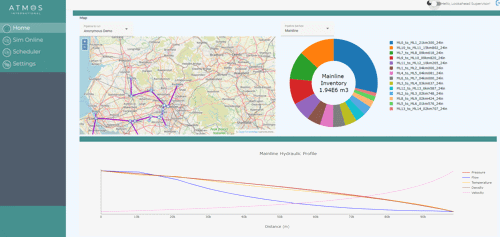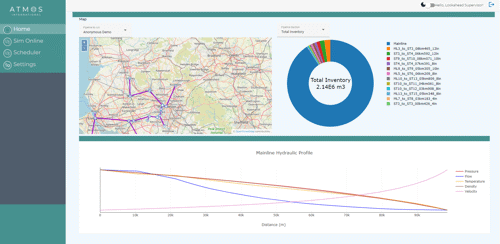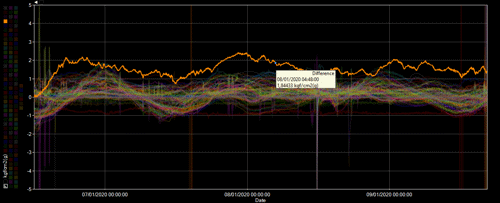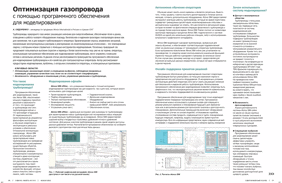Atmos featured in Sphere Oil & Gas magazine
Andrejs Sidorenko, Sales Manager, Russia & CIS, Atmos International, has written an article on the benefits of pipeline simulation software for gas pipelines in the Russian language industry magazine, Sphere Oil & Gas.
Gas pipeline optimization with simulation software
Introduction
Natural gas pipelines are critical to the energy supply for keeping houses warm, lights on and equipment running everywhere. Running gas pipelines safely and reliably is essential for the general public as well as every pipeline company. Meeting demand, managing linepack, minimizing operating costs, and responding to unplanned outages are everyday challenges that can be managed through the use of simulation tools. As natural gas continues to be in high demand and the move to greener gas progresses, operators using pipeline simulation software are able to manage complex networks across multiple regions.
This article looks into the benefits of pipeline simulation software and its advantages for gas operators. The author will review the background of simulation, challenges faced by operators and potential applications .
Key areas:
- Optimization: minimizing costs and reducing emissions, meeting daily nominations, managing gas quality/off spec gas
- Safety: leak detection and location, pipeline pressure management
What is pipeline simulation?
From initial design, through development of operating philosophy and operator training, then in to live operations, simulation software such as Atmos SIM provides powerful decision support based on what is happening in the pipeline or network now and what will happen in the future, helping many gas pipeline operators save money and make better operational choices.
Off-line design
Atmos SIM can be used to design new pipelines or carry out expansion studies on existing assets. Pipeline capacity, compressor sizing and even control system design are all covered in a single tool. Atmos SIM offline is an advanced, accurate pipeline simulation tool for both liquid and gas pipelines that can be used for the following:
- Pipeline design
- Equipment sizing
- Feasibility studies
- Engineering design
- Capacity studies
- De-bottlenecking
- Hydraulic analysis
- Detailed equipment modelling
- Surge analysis
- Flow assurance
Atmos SIM offline is an ideal tool for a pipeline engineer to design new pipelines, or to test new operations on existing pipelines prior to implementation.
Atmos SIM provides a wide selection of industry standard pipe flow equations and equations of state. Different flow equations are available for different pipeline sections within the same model.
Off-line operator training
Training can be time consuming and expensive, rather than shadowing an experienced controller for many months, Atmos SIM provides a flight-simulator type tool that exposes controllers to unplanned events and automatically grades their responses. This can be achieved within an offline environment that does not affect the actual operations of the physical pipeline within a much shorter time. The Atmos SIM Trainer comprises of an instance of the Atmos SIM transient pipeline simulator connected to a SCADA system on one or more workstations. Atmos SIM models the pipeline scenario selected for the training session and provides the corresponding hydraulic response to various commands from the pipeline controller.
On-line decision support
Simulation software helps pipeline operations respond quickly to ongoing changes in supply and demand or equipment availability. Under abnormal operating conditions, controller actions can be critical to safe and reliable operation of pipelines. Using simulation software ensures the controller has confidence that the operational decisions are the correct ones and security of supply is maintained.
Gas simulation software models the hydraulic behavior of gas pipelines or networks accurately. The software can be used online for real-time operations and gas day planning, or offline for predictive analysis and long-term planning.
Additional benefits include model-based leak detection and location, PIG tracking, composition tracking, planning for future operations eg delivering nominations during a compressor outage.
All of this information is presented via a state-of-the-art Web GUI with support for multiple languages and unit sets.


Why use a simulation system?
Access to unmetered areas
Pipelines with large unmetered areas, such as subsea networks, rely on a simulation system to monitor the behavior of the pipeline. Most subsea pipelines do not have any intermediate measurements available due to the high cost of installation and maintenance. Additionally, all installed instruments are consistently monitored for accuracy and drift. At the 2021 API Pipeline Control Room and Cybernetics Conference TBG Brazil highlighted this functionality as one of the key benefits of using Atmos SIM.
The graph below shows the error estimated by Atmos SIM for all pressure meters, you can see the orange line shows one instrument with a clear error associated with it.

Look-ahead capability
Accurate modelling means controllers can be confidently that future operating regimes are secure, pipeline operators can run their operations efficiently. Warnings are given if the operating schedule will violate allowable operating limits or introduce demand constraints.
Revenue increase
It is possible to increase revenue and reduce penalty by the use of simulation software. For example, Gassco, Europe’s leading natural gas supplier, runs the largest subsea gas pipeline network in the world. A cost benefit analysis noted a saving of 7.5 m USD per annum as a result of running a few operational scenario simulations.
Emission reduction
The simulation software can help controllers run the gas pipeline networks efficiently, minimizing the use of fuel or gas used by compressors while meeting the nominations. The fast detection and accurate location of leaks will also reduce the gas released. These features will help reduce emissions thus contributing towards the long-term net zero goal.
Benefits of simulation on a gas network
Real-time decision support
Atmos simulation systems use maximum likelihood state estimation (MLSE) to minimize the effects of varying metering quality . It differentiates measurements from good quality meters from those that are less accurate meaning the simulation results are as good as your best metering, not as bad as your worst like many competitors’ systems. Additionally Atmos SIM’s unique variable knot spacing combined with an industry leading choice of equations of state means the SIM core engine is very fast and suitable for any type of gas, or even liquids.
[IMAGE: The real-time modeling (RTM) module provides an ‘as it happens’ display of pipeline information.]
Alongside real-time modelling, lookahead capabilities are a key feature of the system. They use the current state as a starting point for analysis of what will happen in the future.
Features of Atmos SIM gas simulation
- Simulation of any gas, for example Natural gas, pure Hydrogen and Hydrogen blends, low pressure ethylene.
- Live gas compositions from GC’s can be assigned to different inlets and tracked throughout the network
- Maximum capacity utilization using look-ahead simulations
- Increase of short-term sales using look-ahead simulations
- Notification of off-specification deliveries
- Model-based leak detection and leak location
- Linepack management
- Virtual instrumentation
- Composition/quality tracking
- PIG tracking
- Survival time analysis
Atmos Simulation software
Atmos SIM is 100% graphically configured making it intuitive to use. The comparison table below highlights the features Atmos SIM provides compared to other pipeline software products.

Leak detection on gas pipelines
Atmos SIM leak detection module continuously calculates the volume balance. This volume balance is obtained by calculating the total flow into the system minus the total flow out of the system corrected by the inventory changes. The volume balance is statistically analyzed by the sequential probability ratio test (SPRT), which calculates the ratio of leak probability over no-leak probability. This ratio is then tested against certain threshold values to provide leak warnings/alarms. The threshold value is usually set such that the false alarm probability is lower than 1%.
Atmos SIM also monitors the discrepancies between measured and calculated pressures and flows. These discrepancies are processed by the sequential probability ratio test in order to generate reliable leak alarms.
Atmos SIM leak detection is backed by over twenty-five years of experience of providing effective leak detection systems to some of the world’s largest pipelines..
Atmos Simulation in operation
Atmos SIM Online is used in over 15 countries including Europe, Australia, the Middle East and South East Asia. One of the largest simulation systems is Norway’s Gassco pipelines, covering over 8,000 km of a subsea gas pipeline network. The operation also includes the use of a leak detection system, look-ahead modelling, peak tracking and scraper tracking.
The future of simulation
Artificial intelligence and Internet of Things (IOT) will likely play a major role in the development of simulation. The addition of scalable cloud processing, AI and machine learning will enable the fast delivery of operational plans to control rooms. The transition to greener gas requires the adaptation of existing natural gas networks to incorporate hydrogen. Simulation will play an important role in this transition.
Things to consider
- What are your goals?
- Needs vs wants
- What budget do you have set aside (cost benefit ratio)?
- CAPEX or OPEX budget considerations
- Evaluation and operational trials
- Select the right partner
Contact us
To learn more about Atmos’ simulation solutions and suitability for your gas operations, please contact us.
To read the article in Russian click the image below and see pages 76-80.
